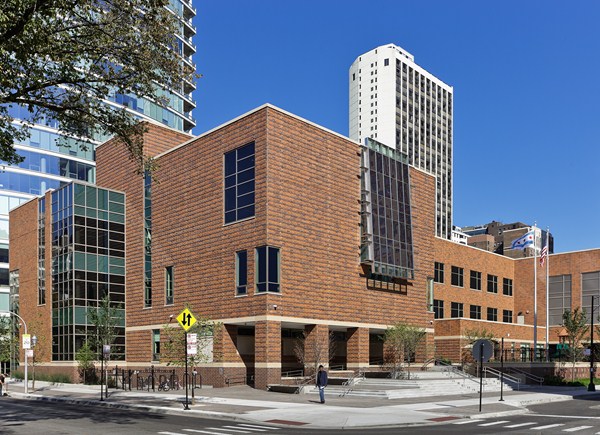The Brick Industry Association (BIA) has opened entry submissions for its 2013 Brick In Architecture Awards—with a new Renovation/Restoration category and new category divisions this year. BIA’s annual awards honor architectural excellence and sustainable design nationwide that incorporates clay brick products as the predominant exterior building or paving material. Entries are due by April 30. To enter and for details, go to: http://www.gobrick.com/EventsEducation/BrickInArchitectureAwards/tabid/7661/Default.aspx
The 2013 awards competition will be conducted entirely online. Architectural and design firms from around the country can enter their best material to be judged by a jury of their peers.
“As a versatile building material made in America made from abundant natural resources, there is no substitute for genuine clay brick,” said BIA President and CEO Gregg Borchelt, P.E. “In addition to its unmatched durability and many benefits from its physical properties, brick offers aesthetic flexibility to match the architect’s imagination and desires, and is a main element in sustainable design,” he said.
As the largest and most prestigious juried competition of its kind, entries can be submitted in one or more of the below categories:
- Commercial (Under $10 Million) – New
- Commercial (Over $10 Million) – New
- Education – K-12
- Education – Colleges & Universities (Higher Education)* – New
- Health Care Facilities
- Municipal / Government
- Houses of Worship
- Residential – Single Family
- Residential – Multi-Family
- Renovation (Additions)** / Restoration (Restoring) – New
- Paving & Landscape Projects
*Includes residence halls & academic/administrative buildings
**Additions must use at least 50 percent new clay brick products on the building. Restoration construction must include at least 50% clay brick products, which can either be new or salvaged.
For complete information on eligibility, submission requirements, and judging, visit
http://www.gobrick.com/EventsEducation/BrickInArchitectureAwards/tabid/7661/Default.aspx
Founded in 1934, the Brick Industry Association (BIA) is the nationally recognized authority on clay brick construction representing the nation’s distributors and manufacturers of clay brick and suppliers of related products. Web site: www.gobrick.com /703-620-0010.
Related Stories
| Nov 5, 2013
Oakland University’s Human Health Building first LEED Platinum university building in Michigan [slideshow]
Built on the former site of a parking lot and an untended natural wetland, the 160,260-sf, five-story, terra cotta-clad building features some of the industry’s most innovative, energy-efficient building systems and advanced sustainable design features.
| Nov 4, 2013
Architecture and engineering industry outlook remains positive on all major indicators
While still below pre-recession levels, all of the key indicators in the latest Quarterly Market Forecast (QMF) report from PSMJ Resources remain in positive territory.
| Nov 1, 2013
CBRE Group enhances healthcare platform with acquisition of KLMK Group
CBRE Group, Inc. (NYSE:CBG) today announced that it has acquired KLMK Group, a leading provider of facility consulting, project advisory and facility activation solutions to the healthcare industry.
| Oct 31, 2013
74 years later, Frank Lloyd Wright structure built at Florida Southern College
The Lakeland, Fla., college adds to its collection of FLW buildings with the completion of the Usonian house, designed by the famed architect in 1939, but never built—until now.
| Oct 31, 2013
CBRE's bold experiment: 200-person office with no assigned desks [slideshow]
In an effort to reduce rent costs, real estate brokerage firm CBRE created its first completely "untethered" office in Los Angeles, where assigned desks and offices are replaced with flexible workspaces.
| Oct 30, 2013
15 stellar historic preservation, adaptive reuse, and renovation projects
The winners of the 2013 Reconstruction Awards showcase the best work of distinguished Building Teams, encompassing historic preservation, adaptive reuse, and renovations and additions.
| Oct 30, 2013
11 hot BIM/VDC topics for 2013
If you like to geek out on building information modeling and virtual design and construction, you should enjoy this overview of the top BIM/VDC topics.
| Oct 29, 2013
Increased backlogs, margins lead to renewed optimism in global construction
After prolonged economic uncertainty, a majority of executives in the global engineering and construction sector have fresh confidence in the growth prospects for the industry, according to KPMG International's 2013 Global Construction Survey. A general increase in backlogs and margins is giving cause for optimism across the industry, with further growth anticipated.
| Oct 29, 2013
BIG opens subterranean Danish National Maritime Museum [slideshow]
BIG (Bjarke Ingels Group) has completed the Danish National Maritime Museum in Helsingør. By marrying the crucial historic elements with an innovative concept of galleries and way-finding, BIG’s renovation scheme reflects Denmark's historical and contemporary role as one of the world's leading maritime nations.
| Oct 28, 2013
Urban growth doesn’t have to destroy nature—it can work with it
Our collective desire to live in cities has never been stronger. According to the World Health Organization, 60% of the world’s population will live in a city by 2030. As urban populations swell, what people demand from their cities is evolving.

















